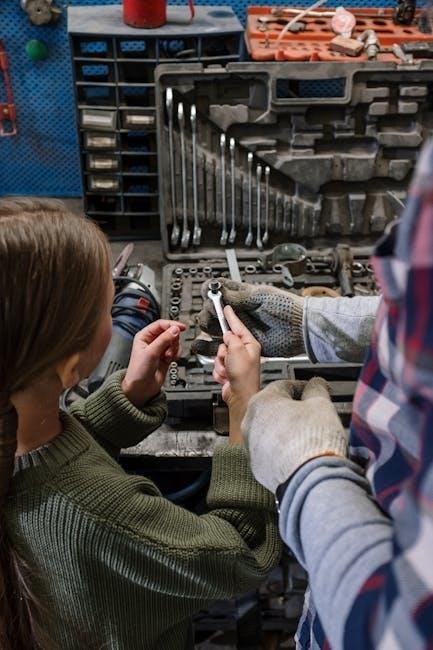Welcome to the Bartender Training Manual, your comprehensive guide to mastering the art of bartending. This manual provides standardized training, ensuring consistency and excellence behind the bar.
1.1 Purpose and Scope
The purpose of this manual is to provide a standardized approach to bartending training, ensuring consistency in drink preparation, service, and safety protocols. Its scope covers essential techniques, tools, recipes, and workplace responsibilities, equipping bartenders with the knowledge and skills needed to excel in their roles while maintaining high professional standards.
1.2 Importance of Standardized Training
Standardized training ensures consistency, efficiency, and quality in bartending practices. It streamlines operations, reduces errors, and enhances customer satisfaction. By following established protocols, bartenders maintain safety, hygiene, and professional standards, fostering a positive workplace culture and elevating the overall guest experience.
Welcome to the bar section, where you’ll learn about bar layout, setup, and essential practices. This section covers the fundamentals of bar operations and standards;
2.1 Understanding Bar Layout and Setup
A well-organized bar layout enhances efficiency and customer satisfaction. The setup typically includes zones for drink preparation, storage, and service. A clean, logical design ensures easy access to tools, ingredients, and equipment, streamlining workflows. Proper setup also promotes safety, hygiene, and a professional environment, making it easier for bartenders to deliver exceptional service.
2.2 Bar Policies and Standards
Adhering to bar policies and standards is crucial for maintaining a professional and safe environment. This includes proper sanitation, responsible serving practices, and dress code adherence. Clear guidelines ensure consistency in service, quality, and customer satisfaction. Policies also outline procedures for handling cash, managing inventory, and addressing customer complaints, fostering a structured and efficient workplace culture.

Bartending Tools and Equipment
This section covers essential tools like shakers, jiggers, and muddlers, and provides guidance on equipment maintenance to ensure longevity and optimal performance.
3.1 Essential Tools Every Bartender Needs
A bartender requires specific tools to excel, including a Boston shaker, jigger, muddler, Hawthorne strainer, bar spoon, citrus juicer, and knife. These tools enable precise measurements, efficient mixing, and creative preparation of cocktails, ensuring consistency and quality in every drink served.
3.2 Equipment Maintenance and Care
Proper maintenance of bartending equipment is crucial for longevity and hygiene. Regularly clean and sanitize tools like shakers, jiggers, and muddlers. Store equipment in dry, secure areas to prevent damage. Inspect tools for wear and tear, replacing parts as needed. Ensure all machinery, such as blenders and ice crushers, is cleaned and lubricated according to manufacturer guidelines to maintain efficiency and safety.
Fundamentals of Bartending Techniques
Mastering essential bartending techniques is the foundation of a successful bartender. This section covers mixing, shaking, and stirring methods, as well as measurement and pouring skills.
4.1 Mixing, Shaking, and Stirring
Mixing, shaking, and stirring are fundamental techniques in bartending. Shaking combines ingredients with ice, creating a refreshing texture. Stirring is used for clear spirits to maintain clarity. Mixing blends flavors without chilling, ensuring balance. Mastering these techniques enhances drink quality and presentation, essential for professional bartenders to deliver consistent and visually appealing cocktails every time.
4.2 Measurement and Pouring Techniques
Accurate measurement ensures consistent drink quality and prevents over-pouring. Use jiggers for precise liquor measurements, and practice pouring techniques like “pouring by count” to maintain consistency. Proper pouring minimizes waste and enhances efficiency. Mastering these skills is essential for delivering high-quality cocktails and maintaining profitability in a fast-paced bar environment.

Cocktail Recipes and Drink Preparation
This section covers essential cocktail recipes and techniques, focusing on classic and modern drinks. Learn to prepare beverages with precision, balancing flavors and Presentation effectively.
5.1 Classic Cocktail Recipes
Mastering classic cocktails is fundamental for any bartender. From the Old Fashioned to the Margarita, these timeless recipes form the foundation of mixology. Learn precise measurements, techniques, and flavors to craft iconic drinks like the Daiquiri, Manhattan, and Mai Tai. Understanding these essentials ensures versatility and the ability to innovate while respecting tradition.
5.2 Modern Cocktail Variations
Modern cocktails blend creativity with tradition, incorporating fresh flavors and innovative techniques. Explore variations like smoked Old Fashioneds or spicy Margaritas, using unique ingredients such as activated charcoal, matcha, or house-made infusions. These recipes encourage experimentation while maintaining balance and flavor profiles, allowing bartenders to craft distinctive drinks that appeal to adventurous palates and keep menus fresh and exciting.
5.3 Flavor Profiling and Pairing
Flavor profiling and pairing are essential for crafting balanced cocktails. By understanding sweet, sour, bitter, and umami elements, bartenders can create harmonious flavor combinations. This skill enhances drink pairings with food, elevating the dining experience. Experimenting with unique ingredients and classic combinations refines flavor intuition, ensuring each cocktail is both innovative and appealing.

Safety and Sanitation Protocols
Safety and sanitation are critical to preventing foodborne illnesses and maintaining a clean environment. Proper hygiene practices, equipment cleaning, and waste management ensure a healthy workspace for staff and customers.
6.1 Preventing Foodborne Illnesses
Preventing foodborne illnesses is a top priority in bartending. Proper hand washing, safe food storage, and sanitizing surfaces are essential. Staff must understand how to handle ingredients to avoid contamination. Regular inspections and training ensure adherence to hygiene standards, protecting both customers and employees from potential health risks.
6.2 Cleaning and Hygiene Practices
Cleaning and hygiene are critical to maintaining a safe and healthy bar environment. Regular sanitization of tools, surfaces, and equipment is essential. Bartenders must wipe down surfaces after each use, clean glasses thoroughly, and ensure all utensils are sterilized. Proper trash disposal and frequent handwashing are also vital to prevent contamination and maintain a clean workspace throughout service.
Customer Service and Communication Skills
Customer service is vital for creating a welcoming bar environment. Bartenders must develop strong communication skills to understand patron needs, ensuring positive interactions and building trust and loyalty.
7.1 Building Rapport with Customers
Building rapport with customers is essential for creating a positive bar experience. Bartenders should practice active listening, maintain eye contact, and engage in friendly conversation. Understanding patron preferences and adapting interactions accordingly fosters trust and loyalty. A welcoming demeanor and genuine interest in customers’ needs enhance satisfaction and encourage repeat visits, making the bar a cherished destination.
7.2 Handling Special Requests and Complaints
Handling special requests and complaints requires patience and professionalism. Bartenders should listen attentively, remain calm, and address concerns promptly. Offering solutions or alternatives demonstrates commitment to customer satisfaction. Documenting issues and communicating with management ensures resolution and improves service quality. Effective complaint management enhances customer loyalty and maintains a positive bar environment.
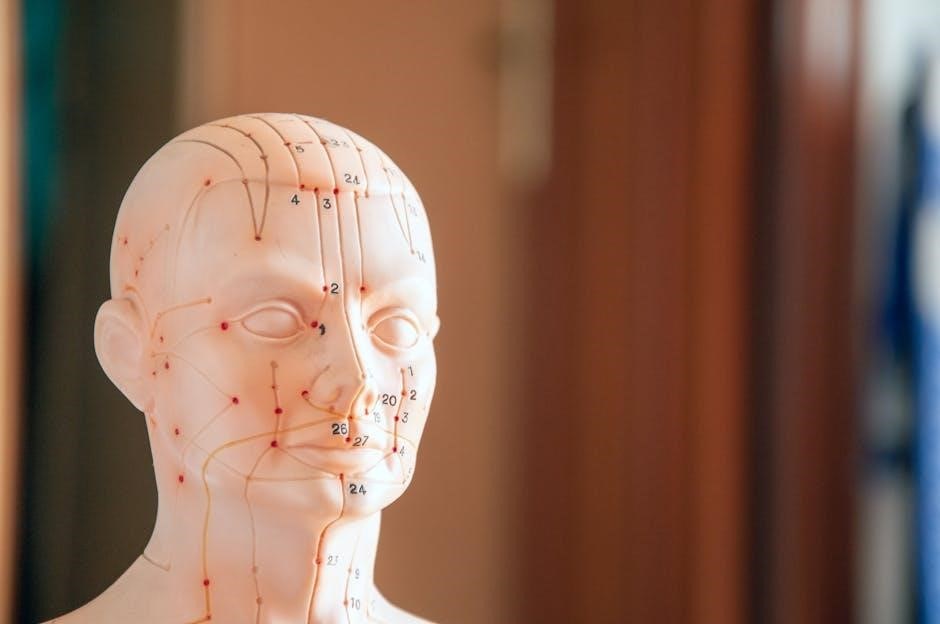
Legal Aspects and Responsible Serving
This section covers essential legal aspects and responsible serving practices, ensuring bartenders understand their role in maintaining compliance and upholding ethical and professional service standards.
8.1 Age Verification and ID Checks
Age verification is crucial to prevent underage drinking. Bartenders must check IDs to confirm patrons are of legal drinking age, using valid government-issued identification. This ensures compliance with legal requirements and protects the establishment from liability. Proper verification techniques and understanding of fake ID detection are essential skills for responsible service.
8.2 Recognizing and Managing Intoxicated Patrons
Recognizing intoxication is crucial for maintaining a safe environment. Look for signs like slurred speech, unsteady movements, or aggressive behavior. De-escalation techniques, such as calm communication and offering water, can prevent conflicts. If patrons become disruptive, involve security and document the incident for legal purposes. This ensures both patron and staff safety while adhering to legal standards.
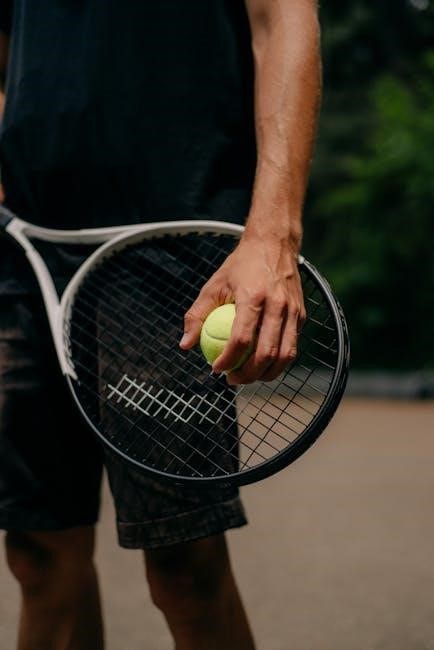
Cash Handling and Point-of-Sale Systems
Mastering cash handling and POS systems is essential. Ensure accuracy in transactions, manage cash and tips effectively, and maintain accountability for a smooth operation.
9.1 Operating POS Systems Effectively
Learn to efficiently use POS systems for accurate transaction processing, order management, and report generation. Understand how to handle discounts, split payments, and refunds. Ensure proper login/logout procedures and maintain transaction records for accountability. Familiarize yourself with system shortcuts to enhance speed and accuracy during peak hours. Proper training ensures smooth operations and minimizes errors.
9.2 Managing Cash Transactions and Tips
Accurately handle cash transactions, ensuring correct change and secure storage. Tips are a significant part of a bartender’s income; manage them transparently and report them as required. Maintain proper records of cash sales and gratuities for accountability. Follow establishment policies for tip pooling or sharing. Always adhere to legal and ethical standards when handling finances to uphold trust and integrity.

Time Management and Multitasking
Effective time management and multitasking are crucial for bartenders to ensure seamless service. Prioritize tasks, manage multiple orders, and maintain efficiency while delivering excellent customer experiences consistently.
10.1 Prioritizing Tasks During Service
Prioritizing tasks during service is essential for maintaining efficiency and ensuring a smooth operation. Bartenders should categorize tasks by urgency, focusing on completing orders, managing payments, and maintaining cleanliness. Effective task prioritization helps balance multiple responsibilities, ensuring timely delivery of drinks and excellent customer service. This skill is vital for handling high-volume settings and maintaining high service standards consistently.
10.2 Maintaining Efficiency in High-Volume Settings
Maintaining efficiency in high-volume settings requires multitasking, organization, and focus. Bartenders should streamline tasks, such as prepping ingredients and organizing orders, to reduce delays. Effective time management ensures drinks are prepared swiftly without compromising quality. Staying alert and managing workspace cleanliness helps maintain efficiency, even during peak hours, ensuring customer satisfaction and smooth service delivery.
Wine and Beverage Knowledge
Understanding wine varieties, beer, and spirits is essential for bartenders. This section covers flavor profiles, pairings, and how to enhance customer satisfaction through informed recommendations.
11.1 Understanding Wine Varieties and Pairings
Mastering wine varieties, from red, white, and sparkling to dessert wines, is crucial for bartenders. Understanding flavor profiles, tannins, acidity, and sweetness helps in pairing wines with dishes effectively. This knowledge enhances drink recommendations, elevating the dining experience and customer satisfaction. Learning key grape varieties like Chardonnay, Merlot, and Champagne is essential for confident pairing suggestions.
11.2 Exploring Beer and Spirits
Understanding beer and spirits is vital for bartenders. Beer categories include ales, lagers, stouts, and porters, each with unique flavors. Spirits like vodka, gin, rum, whiskey, and tequila form the base of many cocktails. Knowing their origins and flavor profiles helps in crafting signature drinks, enhancing your ability to recommend and serve beverages effectively.

Advanced Bartending Techniques
This section explores advanced bartending techniques, focusing on innovation and presentation. It provides insights into modern mixology and enhancing drink aesthetics for professional bartenders.
12.1 Molecular Mixology and Innovation
Molecular mixology introduces scientific techniques to create unique cocktails. This chapter explores innovative methods like spherification, foam creation, and flavor encapsulation, transforming traditional drinks into visually stunning experiences. By incorporating tools like liquid nitrogen and sodium alginate, bartenders can push creativity and elevate their craft, blending science with art to redefine modern mixology.
12.2 Presentation and Garnishing Techniques
Presentation is key to enhancing the cocktail experience. Learn essential garnishing techniques, from citrus twists to olive placement, to elevate drink aesthetics. Master rimming glasses, layering ingredients, and using fresh herbs for a professional finish. Proper presentation transforms a drink into a visually appealing masterpiece, showcasing creativity and attention to detail.
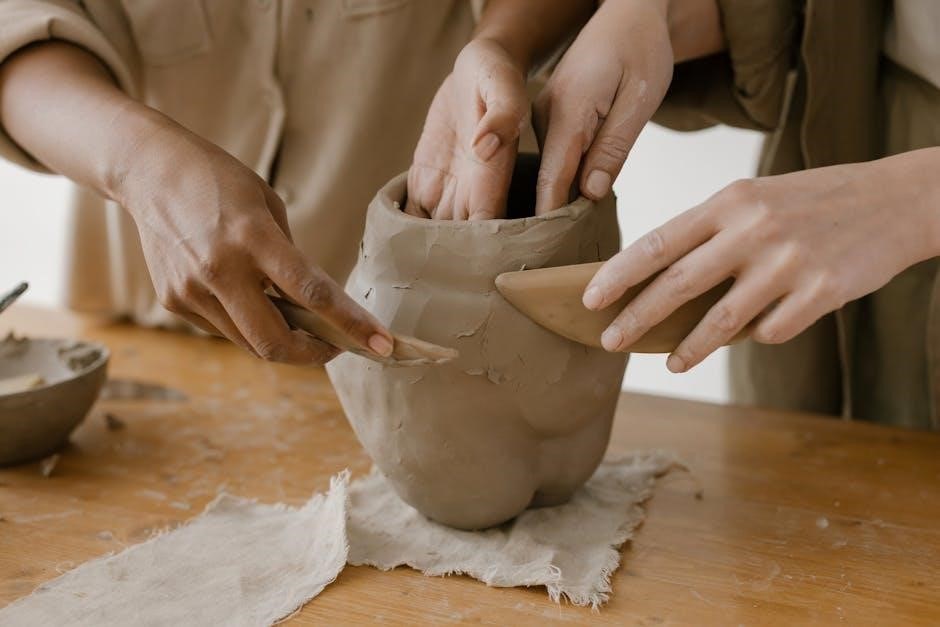
Health and Safety in the Workplace
This section emphasizes the importance of maintaining a safe working environment, proper sanitation practices, and ergonomics to prevent injuries. It also covers mental health support for staff.
13.1 Ergonomics and Injury Prevention
Proper ergonomics and injury prevention are crucial for bartenders to avoid physical strain. Maintain good posture, ensure equipment is at optimal heights, and use correct lifting techniques. Regular breaks and stretching can prevent injuries like back pain or carpal tunnel syndrome. A well-organized workspace reduces accidents, ensuring longevity and comfort in the demanding bartending environment.
13.2 Mental Health Awareness and Support
Mental health awareness is vital for bartenders, as the job can be stressful and demanding. Encourage open conversations about stress and burnout. Provide access to resources like counseling and stress management techniques. Foster a supportive work environment to ensure emotional well-being and resilience. Prioritizing mental health contributes to a positive workplace culture and overall job satisfaction.
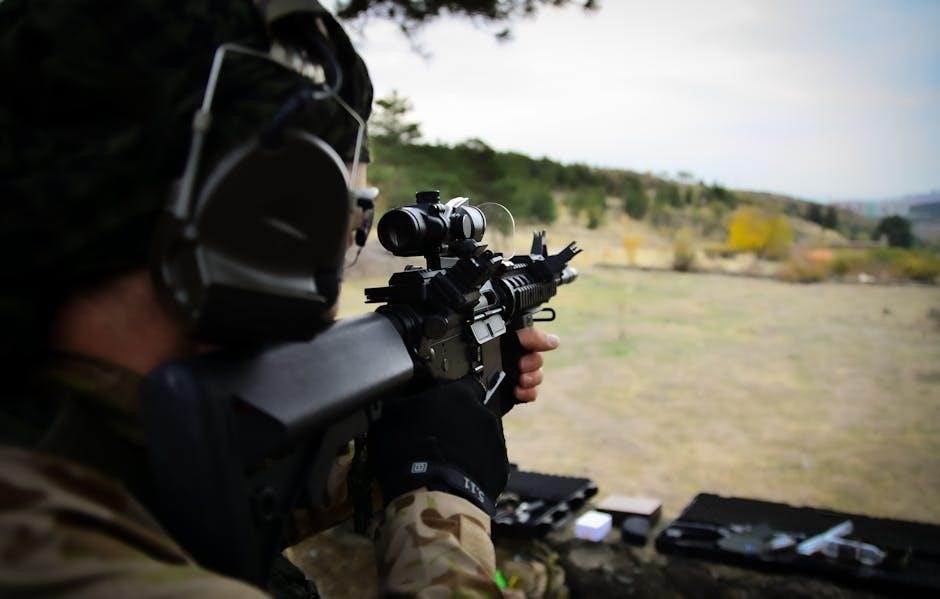
Documentation and Checklists
Documentation and checklists are essential for maintaining consistency and accountability. They ensure tasks are completed efficiently, providing a clear record of processes and performance over time.
14.1 Using Checklists for Consistency
Checklists are a key tool for ensuring consistency in bar operations; They streamline processes, guarantee tasks are completed, and maintain high standards. By following checklists, bartenders can efficiently manage duties, from preparation to closing. This approach minimizes errors, enhances accountability, and ensures compliance with safety protocols. Regular use of checklists also aids in training new staff and adapting to evolving bar needs.
14.2 Maintaining Records and Reports
Maintaining accurate records and reports is crucial for bar operations. This includes inventory management, sales tracking, and compliance documentation. Regular audits ensure data accuracy, while incident logs help address issues promptly. Detailed reports provide insights into trends, supporting informed decision-making. Proper record-keeping also ensures compliance with legal requirements and supports efficient financial management, contributing to the bar’s overall success and accountability.
Continuous Learning and Professional Development
Continuous learning is essential for bartenders to stay updated on trends, techniques, and industry standards. Engaging in workshops, competitions, and certifications fosters professional growth and excellence.
15.1 Staying Updated on Trends and Techniques
Staying updated on trends and techniques is crucial in the fast-paced bartending industry. Attend workshops, competitions, and webinars to learn innovative methods. Experiment with new ingredients and tools to refine your skills. Leveraging online forums and mixology communities can also provide fresh insights and ideas for creative cocktail crafting and improved service delivery.
15.2 Engaging in Workshops and Competitions
Engaging in workshops and competitions enhances bartending skills and fosters creativity. These events provide opportunities to learn from industry experts, refine techniques, and explore new trends. Competitions, in particular, challenge bartenders to innovate and showcase their talents, while workshops offer hands-on training in advanced mixology and customer service strategies, ensuring continuous professional growth and adaptation to industry demands.
By mastering the techniques and principles outlined in this manual, bartenders can deliver exceptional service and continuously grow in their profession. Keep learning and striving for excellence behind the bar.
16.1 Summarizing Key Takeaways
This manual has covered essential bartending techniques, customer service skills, safety protocols, and legal responsibilities. By mastering these areas, bartenders can deliver exceptional service, ensuring safety and satisfaction. Continuous learning and adaptation to trends are crucial for long-term success in this dynamic profession.
16.2 Encouraging Ongoing Learning and Growth
Continuous learning is vital for professional growth in bartending. Engage in workshops, competitions, and mentorship programs to refine skills and stay updated on trends. Embrace innovation, experiment with new techniques, and seek feedback to enhance your craft. Dedication to lifelong learning ensures adaptability and success in this evolving industry.
